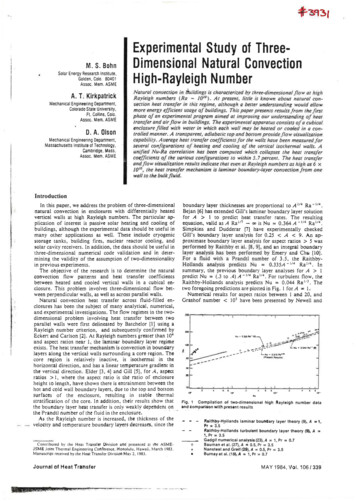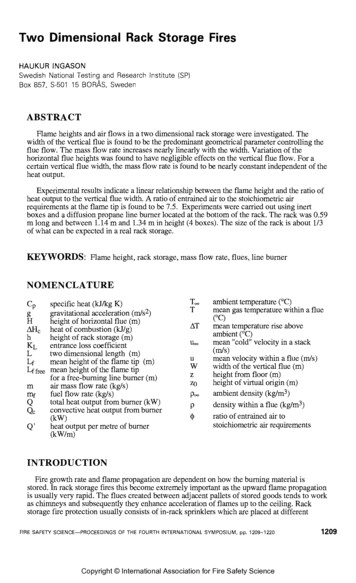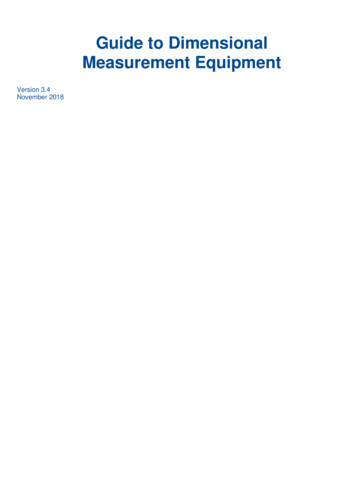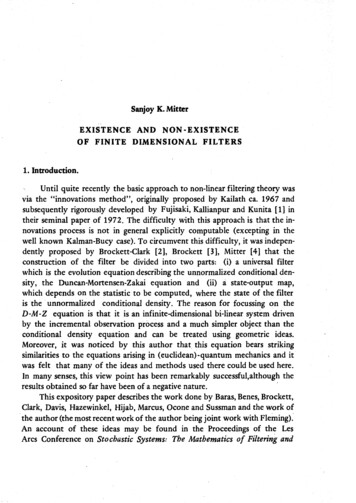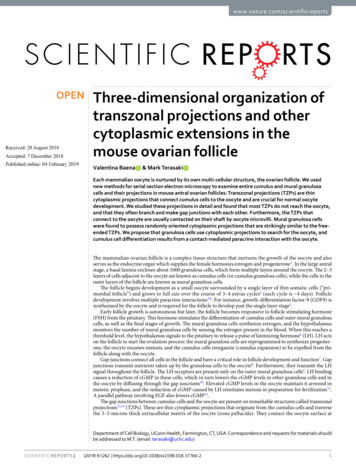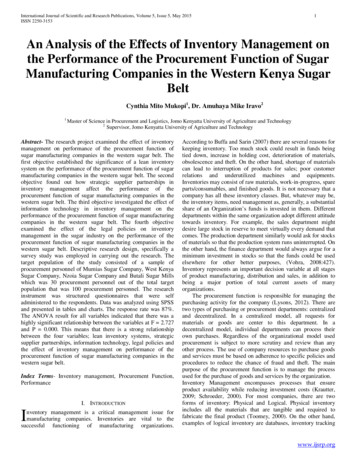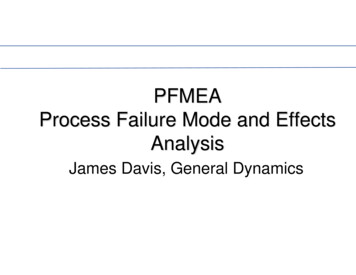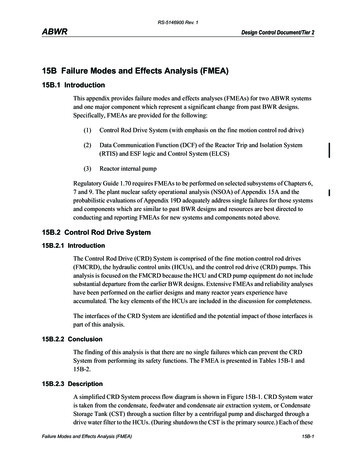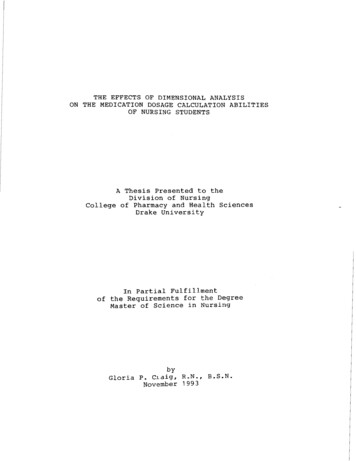
Transcription
THE EFFECTS OF DIMENSIONAL ANALYSISON THE MEDICATION DOSAGE CALCULATION ABILITIESOF NURSING STUDENTSA Thesis Presented to theDivision of NursingCollege of Pharmacy and Health SciencesDrake UniversityIn Partial Fulfillmentof the Requirements for the DegreeMaster of Science in NursingbyGloria P. Craig, R.N.,November 1 99 3B.S.N.
THE EFFECTS OF DIMENSIONAL ANALYSISON THE MEDICATION DOSAGE CALCULATION ABILITIESOF NURSING STUDENTSbyGloria P. Craig, R.N.,B.S.N.Approved by Committee:-h1h-JSandra L. Sellers, Ph.D.,r,hr'-lR.N.DateY Y ? a k y ' ,aansen,' h. ., R.N.DateRichard .' Morrow, Ph-D.Date
TABLE OF CONTENTSPageABSTRACTLIST OF NTRODUCTIONOverview of the ProblemPurpose of the StudyResearch HypothesesDefinition of TermsOverview of the Theoretical FrameworkSignificance to NursingI167799REVIEW OF THE LITERATURETheoretical FrameworkRelated LiteratureSummaryMETMODQEOGYResearch DesignSample and Sampling PlanData Col eckion I n s t r u m e n t sData Collection P r o c e d u r e sProtection of Human SubjectsSummaryFOUR,ANALYSIS QF DATADescription of the SampleResearch Hypothesis 1Research Hypothesis 2Additional FindingsSumaryFIVE,SUMMARY, DISCUSSION, A N D RECOWENDATIONSSummaryDiscussio lLimitationsRecommsndations for Future ResearchSignificance for Advanced Nursing Practice&f6749737677
REFERENCESAPPENDICES1.Demographic Tool2.Medication Calculation Test3.Agency Informed Consent4. Cover Letter5.Student Informed Consent6. Workbook7,Math Research - Quizzes 1-4
ABSTRACTThe purpose of this study was to examine if the useof the problem-solving method of dimensional analysis wouldimprove the medication dosage calculation abilities ofnursing students. To investigate the effectiveness ofdimensional analysis, a quasi-experimental research studywas designed. The 59 nursing students participating inthe study included an experimental group of 30 nursingstudents from a diploma nursing program and a control groupof 29 nursing students from an associate nursing programlocated in central Iowa.Two research hypotheses were proposed for this study.The first research hypothesis was: Nursing students inthe experimental group who are taught dimensional analysiswill demonstrate significantly greater improvement in themedication calculation pretestjpost-test scores than nursingstudents in the control group. This hypothesis wassupported (t 4,96, p .00001).The second research hypothesis was: Nursing studentsin the experimental group who are taught dimensionalanalysis will have higher scores on the medicationcalculation post-test than the nursing students in thecontrol group. This hypothesis was not supported (t -.77,p .78),An additional finding was a slightly inverserelationship with the number of steps and conversions ineach problem when correlated with the number of correctresponses on the post-test for the experimental group(steps/r -0.476, eonversions/r -0.340), control group(steps/r -0,238, conversions/r -0.151) and both groupscombined (steps/r -0.371, conversions/r -0.253).Another finding demonstrated that there was asignificant difference between the pretest scores of theexperimental and control groups (t -5.55, p .0000f ) . Thiswas somewhat expected based on the chemistry andmathematical differences revealed on the demographic tool.The literature identified that dosage calculationdeficiencies are a problem within the nursing discipline.The findings of this study are significant in thattheysupport the use of dimensional analysis as an avenueto be considered when the goal is improvement of medicationdosage calculation abilities, A recommendation from thisstudy is the use of dimensional analysis as a consistentproblem-solving method for teaching medication dosagecalculation to all levels of nursing students.
iiiLIST OF TABLESTable1.PageDemographic Characteristics of Experimentaland Control Groups472.Dependent T-Test Analysis of retestj ost-testDifferences in the Experimental Group493,Dependent T-Test Analysis of retest/ ost-testDifferences in the Control Group504.Independent T-Test Analysis of Mean Differencesin the retest/ ost-testScores of theExperimental and the Control Groups51Independent T-Test Analysis of Differencesin the Post-test Scores of the Experimentaland the Control Groups52Correlations of Number of Steps and Conversionswith the Accuracy of Post-test Scores of theExperimental and the Control Groups63Independent T-Test Analysis of Pretest Scoresof the Experimental and the Control Groups645,6.7,
ACKNOWLEDGMENTSMy sincere thanks to:Dr. Sandra L. Sellers, my thesis advisor, for her expertise,guidance, patience, encouragement, and supportthroughout the process of writing this thesis.Dr. Mary C, Hansen and Dr. Richard J. Morrow, members ofmy thesis committee, for their expertise, critique,and encouragement.Lori M. Craig, my daughter and statistical advisor, forher love, expertise, and encouragement.Susan Garner Moore for allowing me to use her book toresearch the problem-solving method of dimensionalanalysis.Pamela E. Bradley, director, and the students at IowaMethodist School of Nursing for participating inthis study.Mavis A. Hunt, director, and the students at MarshalltownCommunity College for participating in this study.Margaret Cooper, Colleen Hensel, Cissa Schneider, and SheilaVidebeck, faculty members at Iowa Methodist Schoolof Nursing, for assisting with the development ofthe Medication Calculation retest/ ost-test,Nancy O%rien, librarian at Iowa Methodist MedicalCenter, for her expertise and patience.The graduate faculty of the Division of Nursing, DrakeUniversity, for contributing to my education andprofessional growth and development.
CHAPTER ONEINTRODUCTIONOverview of the ProblemEvery nurse must know and practice the five rightsof drug administration:the right drug, the right dose,the right route, the right time, and the right patient.Although nurses may be able to identify the right drug,route, time, and patient, the right dose requiresmathematical, conceptual, and cognitive skills that maypose difficulty for some individuals.With a convenience sample of 1 1 0 subjects, Bindlerand Bayne ( 1 9 9 1 ) identified in a descriptive study that8 1 % of the registered nurses surveyed in four western stateswere unable to calculate medication doses at a 90% levelof proficiency on a 20-item medication calculation test,In addition, they found that 43.6% of the test scores werebelow the 70% level.The investigators suggested thatthis unsatisfactory performance level should be a majorconcern for nurse educators and proposed that the mosteffective way to improve the mathematical calculationabilities of registered nurses would be to incorporatea specific problem-solving methodology into nursingcurricula.
Nursing education programs attest that they graduatesafe, first line practitioners.Some researchers asserted,however, that this may be a misconception (Bindler andBayne, 1991).In a previous descriptive study conductedby Bindler and Bayne (1984), the basic mathematical skillsof 741 baccalaureate nursing students were tested.Bindlerand Bayne identified that the junior nursing students inthe sample were unable to pass from 9% to 38% of the sixparts of the Mathematics Proficiency Exam at a 70%proficiency level.The authors concluded that a substantialnumber of the nursing students did not possess the basicmathematical abilities necessary to function as registerednurses.They strongly recommended that schools of nursingtake an active role in identifying these students andfinding methods to improve their mathematical abilities.No research studies regarding methods for improvingmathematical abilities of nursing students were identifiedin the nursing literature,There were, however, researchstudies and methods suggested in the educational literatureof another discipline.Goodstein (1983) established thata majority of chemistry students were deficient in theirability to deal with the quantitative aspects of the subjectmatter.In an effort to improve the quantitative abilitiesof chemistry students, the chemistry educators utilized
a problem-solving method called dimensional analysis (alsocalled factor label method, conversion-factor method, unitsanalysis, and quantity calculus).Goodstein expressedthat even though the ratio-proportion method was at onetime the primary problem-solving method, it has been largelyreplaced by a dimensional analysis approach in mostintroductory chemistry textbooks.Dimensional analysis was identified in chemistrytextbooks as a problem-solving method as early as 1 9 3 8 .Frey ( 1 9 3 8 ) defined dimensional analysis but did notspecifically explain how this method could be used to solvechemistry problems.Johnson ( 1 9 6 9 ) defined dimensionalanalysis and described why this problem-solving methodshould be used to solve chemistry problems.He did notexplain, however, how this method could be used to solvechemistry problems.Goodstein ( 1 9 8 3 ) described dimensionalanalysis as a problem-solving method that is very simpleto understand, reduces errors and requires less conceptualreasoning power to understand than does the ratio-proportionmethod.She stated that this method condenses multi-stepproblems into one orderly extended solution.Hein ( 1 9 8 3 ) described dimensional analysis as a usefulmethod for solving a variety of chemistry, physics,mathematics, and daily life problems.He identified that
dimensional analysis is often the problem-solving methodof choice because it provides a systematic, straightforwardway to set up problems; gives a clear understanding ofthe principles of the problem; helps the learner to organizeand evaluate data; and assists in identifying errors inthat unwanted units are not eliminated if the setup ofthe problem is incorrect.Peters (1986) identified dimensional analysis as amethod used for solving not only chemistry problems butalso a variety of other mathematical problems that requireconversions.He described dimensional analysis as a methodthat can be used whenever two quantities are directlyproportional to each other and one quantity must beconverted to the other using a conversion factor orconversion relationship.Once the given quantity neededis identified, the unit path (the series of unit conversionsnecessary to achieve the answer) is established.Peters(1986, pp. 25-31) summarized the problem-solving methodof dimensional analysis as follows:Problem:1.3 yards How many inches?Begin with the given quantity.Example:3 yards
2-Establish the unit path from the given quantity tothe wanted quantity, selecting the equations whichwill be used as conversion factors.Example: 1 yard 3 feetExample: 1 foot 12 inches3.Write the setup for the problem, multiplying anddividing in a logical sequence through each stepof the unit path.Given quantity x (One or more conversion factors) Wanted quantity.Example:3 yards How many inches?3 yards x 3 feet x 12 inches I yard1 footNote that every conversion factor is a ratio ofunits which equals 1.4.Cancel units to be certain that the setup gives ananswer expressed in the correct units.Feet cancel.Example:Inches remain as the desired unit.3 yards x 3 feet x 1 2 inches 1 yard5.Yards cancel.1 footMultiply the numerators, multiply the denominatorsand divide the product of the numerators by theproduct of the denominators to provide the numericalvalue of the answer,
Example:3 yards x 3 feet x 12 inches 108 inches1 yard1 footThe nursing literature has identified that many nursesexperience difficulty in calculating medication doses.Chemistry educators have adopted a method that is not onlyeasier to learn but also reduces errors when some typeof mathematical conversion is required.Nurse educatorsshould be interested in the use of dimensional analysisas a method to improve the mathematical abilities of theirstudents.Ultimately, this improved methodology mightwell reduce the medication errors that occur within thediscipline of nursing.Purpose of the StudyThe purpose of this study was to examine if the useof the problem-solving method of dimensional analysis wouldimprove the medication dosage calculation abilities ofnursing students.Specifically, the study examined theproblem solving competence of diploma nursing studentswho were taught to perform medication calculations usingdimensional analysis as compared to the problem solvingcompetence of associate degree nursing students taughtmedication calculations by the traditional problem-solvingmethodologies.
Research HypothesesThe research hypotheses for this study were:1 ursingstudents in the experimental groupwho are taught dimensional analysis willdemonstrate significantly greater improvementin the medication calculation pretest/post-testscores than nursing students in the controlgroup,2,Nursing students in the experimental group whoare taught dimensional analysis will have higherscores on the medication calculation post-testthan the nursing students in the control group.Definition of TermsThe terms used for this study were defined as follows:Experimental group - Experimental group was definedas those nursing students enrolled in the second levelor second year of a diploma nursing program who were taughtto use dimensional analysis to calculate medicationproblems.Control group-Control group was defined as nursingstudents enrolled in the second level or second year ofan associate nursing program who were instructed in theuse of ratio-proportion or desired dose/dose on hand tocalculate medication problems,
Dimensional analysis-Dimensional analysis was definedas a problem-solving method that can be used to calculatemedication dosage problems whenever two quantities aredirectly proportional to each other and one quantity mustbe converted to the other using a conversion factor orconversion relationship.Nursing students-Nursing students were defined asthose students enrolled in the second level or second yearof a two-year associate degree nursing program or of athree-year diploma nursing program located in central Iowa.Medication calculation pretest/post-test-Themedication calculation pretest/post-test consisted of aresearcher-developed, 20-item medication calculation testcontaining a variety of problems that a registered nursewould encounter with medication administration in clinicalnursing practice.Improvement - Improvement was defined as a highertotal score on the medication calculation post-test whencompared with the total score on the medication calculationpretest for each group.Scores - Scores were defined as the number of correctanswers scored on the 20-item medication calcufation
Overview of the Theoretical FrameworkAccording to cognitive theory, learning is dependenton how information is structured, organized andconceptualized.It involves associations establishedaccording to the principles of contact and repetition.Learning is viewed as involving the acquisition orreorganization of cognitive structures through which humansprocess and store information, The items of informationacquired through learning are sorted, filed, andcross-indexed.This allows for meaningful learning andretaining of information in an organized fashion (Goodand Brophy, 1 9 8 6 ) .Dimensional analysis is aproblem-solving approach that is based on cognitive theory.Significance to NursingTwo studies regarding mathematical abilities or thelack of mathematical abilities of registered nurses havesuggested that nurse educators should be concerned aboutthe mathematical skills of practitioners (Bindler and Bayne,1994;1984).Although these studies were performed bythe same researchers, the time span demonstrates that afterseven years the problem with the lack of mathematical skillsof nurses continued and had not improved.Other studies also have identified factors that affectthe mathematical calculation abilities of nurses.Worrell
and Hodson (1989) proposed and verified that inconsistenciesbetween teaching methodologies of nursing faculty membersand the use of different formulas have a negative effecton nursing students' mathematical calculation abilities.Whereas, some nurse educators may use the ratio-proportionproblem solving method, others may use a different methodcreating confusion among students required to performcalculations with multi-step methods.In addition to the two major studies that haveevaluated nursing students' computational abilities (Bayneand Bindler, 1988; Worrell and Hodson, 1989), other studieshave been conducted that also have identified that thedifficulty with mathematical calculations seems to be thestudents' problem-solving abilities as opposed tocomputational skills (Blais and Bath, 1992; Chenger,Conklin, Rirst, Reimer, and Watson, 1 9 8 8 ) .Blais and Bath(1992) recommended that educators teach a method of problemsolving that will allow students to conceptualize theproblem by setting up their mathematical problems in aneat and organized manner that shows the flow of problemsolving,The literature identifies that mathematical and dosagecalculation deficiencies continue to be a problem withinthe nursing discipline.Calculation deficiencies among
nurses or nursing students lead to medication errors thatthreaten patient safety and are costly in terms ofmalpractice litigation.Research is needed to evaluatealternative methods of teaching nurses and nursing studentsto calculate medication problems that arise in clinicalnursing practice.Chemistry educators have identifiedand adopted dimensional analysis as an effective methodthat allows students to solve difficult problems involvingconversions.To this date, however, no formal researchhas been conducted to ascertain whether nursing studentswho are taught dimensional analysis will be more accuratein calculating medication problems that require some typeof conversion.Because mathematical and dosage calculationdeficiencies are a problem, this quasi-experimental researchstudy was conducted to evaluate an alternative method ofteaching nursing students to calculate medication problemsthrough the use of the previously established successfulmethod of dimensional analysis.
CHAPTER TWOREVIEW OF THE LITERATUREThe purpose of this study was to examine if the useof the problem-solving method of dimensional analysiswould improve the medication dosage calculation abilitiesof nursing students.sections.This chapter is divided into threeThe first section describes the theoreticalframework used as the theoretical foundation for the study.The second section discusses research studies relevantto the study.The chapter concludes with a summary ofthe literature review.Theoretical FrameworkThis study researched the use of the problem-solvingmethod of dimensional analysis by nursing students toimprove medication calculation abilities.Goodstein ( 7 9 8 3 )described dimensional analysis as a problem-solving methodthat is very simple to understand; reduces errors; requiresless conceptual reasoning power to understand than othermethods; and condenses multi-step problems into one orderlyextended solution.Hein (1983) identified that dimensionalanalysis provides a systematic, straightforward way toset up problems; gives a clear understanding of theprinciples of the proble;.,;helps the learner to organizeand evaluate data; and assists in identifying errors in
that unwanted units are not eliminated if the setup ofthe problem is incorrect.Peters (1986) describeddimensional analysis as a method that can be used whenevertwo quantities are directly proportional to each otherand one quantity must be converted to the other utilizinga conversion factor or conversion relationship.Afterthe given quantity needed is identified, the unit path(the series of unit conversions necessary to achieve theanswer) is established.Peters (1986, pp, 25-31) summarized the problem-solvingmethod of dimensional analysis as follows:Problem:1.3 yards How many inches?Begin with the given quantity.Example:2,3 yardsEstablish t
nursing students. To investigate the effectiveness of dimensional analysis, a quasi-experimental research study was designed. The 59 nursing students participating in the study included an experimental group of 30 nursing students from a diploma nursing program and a control group of 29 nursing st
